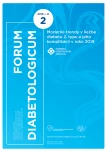Updates in obesity pharmacotherapy
Authors:
Ubomíra Fábryová 1,2
Authors‘ workplace:
Metabol KLINIK s. r. o., Ambulancia pre diabetológiu, poruchy látkovej premeny a výživy, Špecializovaná lipidologická ambulancia, MED PED centrum, Bratislava
1; Biomedicínske centrum SAV, Bratislava
2
Published in:
Forum Diab 2019; 8(2): 71-79
Category:
Review Article
Overview
Obesity is a multifactorially conditioned chronic preventable disease defined by excessive fat accumulation due to an imbalance between energy intake and expenditure. It is a huge problem worldwide, independent of gender, ethnicity and age. The number of obese people is constantly increasing. Pharmacological treatment is an important part of obesity management in addition to lifestyle changing. In the European Union, we currently have three drugs for chronic obesity treatment: orlistat, a combination of naltrexone SR / bupropion SR and liraglutide 3.0 mg. Up to now, the expectations we have had regarding to the available pharmacotherapy of obesity have not been met in terms of safety, efficacy and, in particular, long-term sustainability of reduced weight. The future of personalized obesity pharmacotherapy is based on the concept of developing multilevel drugs with minimal adverse events. Looking at the results of preclinical and clinical trials, it is clear that the treatment of type 2 diabetes mellitus and / or obesity will continue to develop the multifunctional peptides – dual, respectively triple (possibly quadruple) agonists that represent more than one pharmacological activity.
Keywords:
bupropion SR – liraglutide – multifunctional peptides – naltrexone SR – pharmacotherapy of obesity – semaglutide
Sources
- Obesity and overweight. Dostupné z WWW: <https://www.who.int/news-room/fact-sheets/detail/obesity-and-overweight>.
- le Roux CW, Chubb B, Nørtoft E et al. Obesity and healthcare resource utilizations: results from Clinical Practice Research Database (CPRD). Obes Sci Pract 2018; 4(5): 409–416. Dostupné z DOI: <http://dx.doi.org/10.1002/osp4.291>.
- Smatana M, Pažitný P, Kandilaki D et al. Slovakia: Health system review. Health Syst Transit 2016; 18(6): 1–210. Dostupné z WWW: <http://www.healthobservatory.eu>.
- Fábryová Ľ. Súčasná situácia v manažmente obéznych pacientov na Slovensku. Koncept národného komplexného manažmentu obezity v Slovenskej republike. Forum Diab 2018; 7(2): 89–97.
- Avdičová M et al. Monitorovanie rizikových faktorov chronických chorôb v SR. RÚVZ so sídlom v Banskej Bystrici za podpory WHO – regionálnej úradovne v Kodani. 2012. ISBN 978–80- 971096–0-8.
- Tichá Ľ, Regecová V, Šebeková K et al. Prevalence of overweight/obesity among 7-year-old children-WHO Childhood Obesity Surveillance Initiative in Slovakia, trends and differences between selected European countries. Eur J Pediatr 2018; 177(6): 945–953. Dostupné z DOI: <http://dx.doi.org/10.1007/s00431–018–3137–7>.
- Currie C, Zanotti C, Morgan A et al. Social determinants of health and well-being among young people: Health Behaviour in School-aged Children (HBSC) study: international report from the 2009/2010 survey. WHO Regional Office for Europe: Copenhagen 2012 (Health Policy for Children and Adolescents, No. 6). Dostupné z WWW: <http://www.euro.who.int/en/publications/abstracts/social-determinants-of-health-and-well-being-among-young-people.-health-behaviour-in-school-aged-children-hbsc-study>. ISBN 978 92 890 1423 6.
- Yumuk V, Tsigos C, Fried M et al. European Guideline for Obesity Management in Adults. Obes Facts 2015; 8(6): 402–424. Dostupné z DOI: <http://dx.doi.org/10.1159/000442721>.
- Xia Y, Kelton CM, Guo JJ et al. Treatment of obesity: pharmacotherapy trends in theUnited States from 1999 to 2010. Obesity (Silver Spring) 2015; 23(8): 1721–1728. Dostupné z DOI: <http://dx.doi.org/10.1002/oby.21136>.
- Ganguly R, Tian Y, Kong SX et al. Persistence of newer anti-obesity medications in a real-world setting. Diabetes Res Clin Pract 2018; 143: 348–356. Dostupné z DOI: <https://doi.org/10.1016/j.diabres.2018.07.017>.
- Fábryová Ľ. Weight Loss Pharmacotherapy of Obese Non-Diabetic and Type 2 Diabetic Patients. J Obes Weight Loss Ther 2015; 5: 277. Dostupné z DOI: <http://dx.doi.org/10.4172/2165–7904.1000277>.
- Fábryová Ľ. Účinnosť a bezpečnosť moderných antiobezitík: najnovšie dôkazy a manažment pacientov. Interná Med 2016; 16(11): 447–454.
- Fábryová Ľ. Manažment obézneho pacienta. In: Martinka E et al. Interdisciplinárne štandardy diagnostiky a liečby diabetes mellitus, jeho komplikácií a najvýznamnejších sprievodných ochorení. Facta Medica 2018; 2(Suppl 1): 5–153.
- Patel DK., Stanford FC. Safety and tolerability of new generation anti-obesity medications: a narrative review, Postgrad Med 2018; 130(2): 173–182. Dostupné z DOI: <http://dx.doi.org/10.1080/00325481.2018.1435129>.
- Velazquez A, Apovian CM. Updates on obesity pharmacotherapy. Ann N Y Acad Sci 2018; 1411(1): 106–119. Dostupné z DOI: <http://dx.doi.org/10.1111/nyas.13542>.
- Pilitsi E, Farr OM, Polyzos SA et al. Pharmacotherapy of obesity: Available medications and drugs under investigation. Metabolism 2019; 92: 170–192. Dostupné z DOI: <http://dx.doi.org/10.1016/j.metabol.2018.10.010>.
- Valsamakis G, Konstantakou P, Mastorakos G. New Targets for Drug Treatment of Obesity. Annu Rev Pharmacol Toxicol 2017; 57: 585–605. Dostupné z DOI: <http://dx.doi.org/10.1146/annurev-pharmtox-010716–104735>.
- Christensen RM, Juhl RC, Torekov SS. Benefit‑Risk Assessment of Obesity Drugs: Focus on Glucagon‑like Peptide‑1 Receptor Agonists. Drug Saf 2019; 2019. Dostupné z DOI: <https://doi.org/10.1007/s40264–019–00812–7>.
- [ClinicalTrials.gov]. Semaglutide Effects on Heart Disease and Stroke in Patients With Overweight or Obesity (SELECT). NCT03574597. 2019. Dostupné z WWW: <https://clinicaltrials.gov/ct2/show/NCT03574597>.
- O’Neil PM, Birkenfeld AL, McGowan B et al. Efficacy and safety of semaglutide compared with liraglutide and placebo for weight loss in patients with obesity: a randomised, double-blind, placebo and active controlled, dose-ranging, phase 2 trial. Lancet 2018; 392(10148): 637–649. Dostupné z DOI: <https://doi.org/10.1016/s0140–6736(18)31773–2>
- Blundell J, Finlayson G, Axelsen M et al. Effects of once-weekly semaglutide on appetite, energy intake, control of eating, food preference and body weight in subjects with obesity. Diabetes Obes Metab 2017; 19(9): 1242–1251. Dostupné z DOI: <https://doi.org/10.1111/dom.12932>.
- Fosgerau K, Hoffmann T. Peptide therapeutics: current status and future directions. Drug Discov Today 2015; 20(1): 122–128. Dostupné z DOI: <http://dx.doi.org/10.1016/j.drudis.2014.10.003>.
- Sadry S, Drucker D. Emerging combinatorial hormone therapies for the treatment of obesity and T2DM. Nat Rev Endocrinol 2013; 9(7): 425–433. Dostupné z DOI: <http://dx.doi.org/10.1038/nrendo.2013.47>.
- Jall S, Sachs S, Clemmensen C et al. Monomeric GLP-1/GIP/glucagon triagonism corrects obesity, hepatosteatosis, and dyslipidemia in female mice. Molecular Metabolism 2017; 6(5): 440–446. Dostupné z DOI: <http://dx.doi.org/10.1016/j.molmet.2017.02.002>.
- Kahan S, Manson JE. Obesity Treatment, Beyond the Guidelines Practical Suggestions for Clinical Practice. JAMA 2019; 321(14): 1349–1350. Dostupné z DOI: <http://dx.doi.org/10.1001/jama.2019.2352>.
Labels
Diabetology Endocrinology Internal medicineArticle was published in
Forum Diabetologicum

2019 Issue 2
Most read in this issue
- Modern trends in the treatment of hypertension
- Updates in obesity pharmacotherapy
- Modern trends in local treatment of diabetic foot
- Insulin pump treatment in type 1 diabetes mellitus – for whom and why?
